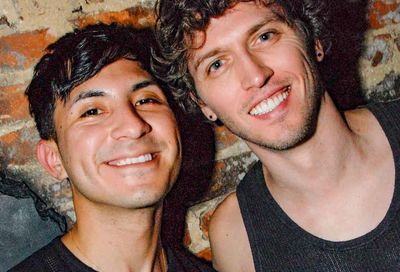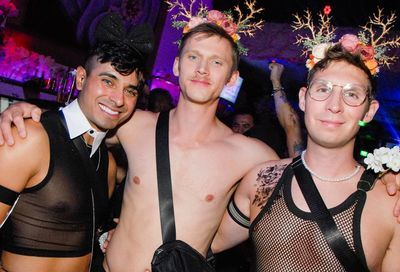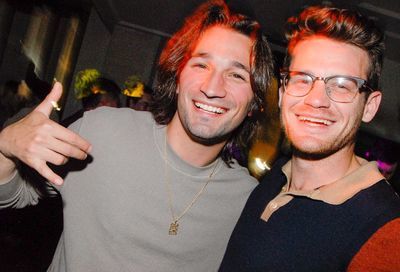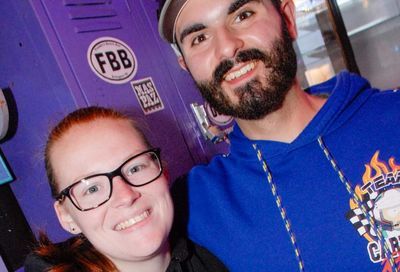Positively Powerful
Project Runway's Jack Mackenroth challenges HIV stigma with a skyrocketing career and abundant charisma
Whitman-Walker Clinic’s black-tie spring gala, “Masquerade on the Mall,” with the breathtaking backdrop of the Andrew W. Mellon Auditorium, is bound to be one of the season’s social highlights. With honors for POZ magazine and Miss America 2010 Caressa Cameron, the glamour shouldn’t outshine the goal, reminding attendees that night’s purpose is to raise money for the clinic in its local fight against HIV and AIDS.
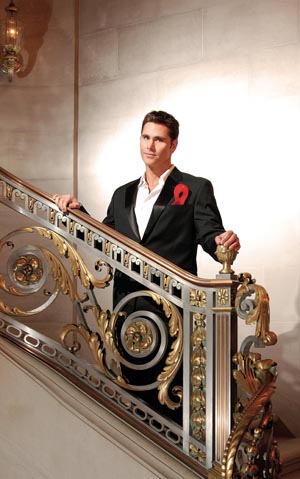
Jack Mackenroth
(Photo by Todd Franson)
Even the gala’s emcee will serve to keep HIV in the minds of the glittering gathered — albeit not with a frown, but with flair. Maybe you caught Jack Mackenroth during his season on Project Runway, cut short by an infection requiring a brief hospital stay. Had he remained on the show, he might be as well known as the season’s winner, his friend Christian Siriano.
“I’m not so arrogant to say, ‘Yeah! I totally would’ve won,'” Mackenroth says of his shot on the reality show of competing fashion designers. “I think I definitely had a run at the final three. But Christian was the perfect winner. He’s obviously the most successful designer in Project Runway history. Plus, he’s hilarious and adorable.”
These days, Mackenroth is doing just fine, propelled into new opportunities by his Project Runway stint. He joined Robert Breining’s radio show, “POZIAM,” and his YouTube parody of Flashdance has gotten nearly 100,000 hits.
Most importantly, he has partnered with Merck & Co., manufacturer of such HIV medications as Isentress and Crixivan, with whom he’s launched the HIV-education program Living Positive by Design. Its main goal is to counter stigma against HIV.
“I’m not immune to stigma,” says Mackenroth, who has been HIV-positive for half of his 40 years. “I battle the same things other people deal with, whether they’re out about it or not. There’s always issues with dating, disclosing…. Fortunately, I’m open. I don’t know if I can think of an instance where I can pinpoint the fact that someone has flat-out said, ‘I will not be involved with you because you are HIV-positive.’ I’m sure it’s happened.”
Mackenroth is fighting that stigma with style and a smile. Although he wants to be sure you know he is someone living with HIV, it’s not the conventional portrait. Mackenroth has boundless energy, exuberance and joie de vivre. Indeed, during an afternoon interview at the Mellon Auditorium, he can’t resist a couple spins on the ballroom floor, already eager for the masquerade gala to begin.
“I’m designing my mask,” he says. “And I’m very approachable. So if you’re a fan, come talk to me, hang out and take pictures.”
He adds with a laugh and his priceless smile, “You can Tweet about me.”
METRO WEEKLY: Your bio tempts me to divide you into three parts: swimming, fashion and activism. I know the least about the swimming.
JACK MACKENROTH: I started swimming competitively when I was 6. I come from a swimming family — brother, sister, we all swam. I started taking it seriously when I was about 12. When I moved to New York, I started swimming with Team New York Aquatics, which is the gay masters-level team there. I recently went to the Out Games in Copenhagen and I won eight medals. I’m training right now for the Gay Games, this July and August in Cologne, Germany. I’m a sprinter now, because I’m too old to do anything else. [Laughs.] I’m a sprint breaststroker and sprint freestyler.
MW: How will you celebrate turning 41 this month?
MACKENROTH: I’m not doing anything. I’ll be swimming at swim camp in Florida. You know, 41 is like a pfft birthday anyway. [Laughs.] I’m going back! That’s what I’m doing for my 41st: I’m turning 30.
MW: What’s your regimen?
MACKENROTH: I swim probably five or six times a week, hour-and-a-half long practices with a team and a coach. I lift weights pretty much every day.
I’m actually too big for swimming right now. If I’m going into a competition, I’ll rest up and stop lifting weights. I’m six-foot and weigh about 200 pounds, so I need to lose weight for competition. I try to eat healthy, but I’m not a freak about what I eat.
MW: Before I move to fashion, I need to put you on the spot and ask, if it were up to you, where would you have put the 2014 Gay Games? Boston, Cleveland or Washington?
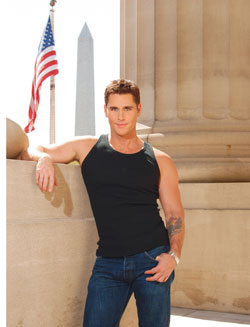
Jack Mackenroth
(Photo by Todd Franson)
MACKENROTH: Ooh, D.C! [Laughs.]
MW: Okay, moving on. You started sewing in high school?
MACKENROTH: I taught myself to sew on my grandmother’s sewing machine when I was 13. I just started making clothes. It was total trial and error. Being kind of alternative, I would take my old clothes that my mom bought me and then retool them. I’d come down in some hideous outfit, and she’d be like, “Oh, my God.” We didn’t have a lot of money, so she’d get really irritated that I would take stuff apart and put it back together. But that was really the impetus for my whole design career.
I went to this really conservative, preppy school, the high school Bill Gates went to: Lakeside School. They all thought I was a freak. I had my Army jacket with “Depeche Mode” and “The Cure” written across the back. I have a driver’s license photo where my hair’s blond on top and black underneath. I think I had every haircut there was.
By the time I got to college, I was better at design. I always did a lot of visual arts. But I went to Berkeley to become a doctor. My dad’s a doctor, my mom’s a nurse. I was pre-med for two years and then I realized that actually being an artist or being a designer was a career. I had thought it was a hobby.
When I realized that, I called my mom. I came out when I was 18 in my freshman year. I called her in my sophomore year and said, “Also, I’m not going to be a doctor.” [Laughs.]
When I told her I was gay, she thought it was shocking — which I thought was hilarious. She said, “Come to think of it, you did like to wear my nightgowns when you were 5.” I was like, hello. I kind of had an all-access card after that. She was dealing with that, so when I told her any other important news, she was like, “Whatever.” Once we were over the big hurdle, the rest was okay.
So that’s kind of where it all started. Then I took a lot of art classes. I double-majored in fine arts and sociology. Right after I graduated from Berkeley, in ’91, I went to Parsons [The New School for Design] in New York and that was that. I piled all my stuff on top of a car and drove cross-country.
MW: How often do you make it back to Seattle?
MACKENROTH: A couple times a year. All my family’s still there. I left when I was 18 and I never really went back. There are a few friends still there, but most of them are gone. But my brother and sister are really cool. I’m glad [my mother] lives 3,000 miles away from me — I love her to death — because when I go home to Seattle she treats me like I’m in sixth grade again.
MW: How did Project Runway fit into your career in New York?
MACKENROTH: I was a fashion designer for 16 years before I went on the show — beyond making crazy costumes for myself. At the time I went onto Project Runway I was design director at this company called Weatherproof. I sat at a desk and had a very good job and it was fairly predictable.
Then Project Runway came along. I’ve always approached life like, “Oh, this might be a really cool adventure. Who knows what’s going to happen?” When it did happen, and subsequently all these other opportunities happened, I was like, “Oh, this might by fun,” not, “Oh, I want to be the next Ryan Seacrest and have all my own shows!”
MW: Post-Project, what are you doing with your career?
MACKENROTH: I’m doing so many things professionally. Project Runway really changed my life 180 degrees. I still do design, but I do it for myself, on a commission basis. But I do so many other things. I do Living Positive by Design with Merck. I just filmed a pilot for — I don’t know how much I can say about it — but it’s a fashion game show where I’m a judge. I’m producing another television show called The Queens of Drag, which is basically like a Real Housewives setup, but it’s all the top drag queens in New York City.
The thing that’s interesting about reality TV is it’s a platform. It’s exposure. That’s really all it is. Beyond that, it’s what you make of it. It’s really hard work. People have this misconception that you go on TV, you become “famous,” people see you, and then your life’s cush. While that’s kind of true, that lasts for about three months. Then the next show is on, the next season is on, and people forget who you are and you really have to work.
MW: So maybe being the next Ryan Seacrest would be an ambition? Or would you prefer to open the House of Mackenroth fashions?
MACKENROTH: That’s an ambition. It’s both. All of the above. The issue with fashion design, which I think a lot of people don’t realize is — and Christian Siriano, the winner of my season, is a good example of this — doing it fulltime under your namesake label is all-consuming. I couldn’t do any of the other projects I do. He actually has a show that follows his life. I’m good friends with him, but getting hold of him — other than dropping in on him — he’s like, “I have no friends, I work all the time.”
For me, it’s to have a much fuller, less-crazy life. Doing what I do right now is where I want to be. I’m a designer. I paint. I throw pottery. I’m working on a book, a memoir. I do a radio show, “POZIAM,” on Sunday nights.
MW: Are you happy to have gotten out from behind that desk?
MACKENROTH: Totally. I mean, at that point I was happy to pay my mortgage. Then I was like, “Oh, I get to have fun and pay my mortgage?” Great. Handled. It’s good.
MW: Tell me, in your own words, about Living Positive by Design.
MACKENROTH: Living Positive by Design is a partnership with Merck. Basically, it’s an HIV-education campaign on a national level.
I’d done a story for The Advocate about my experience on Project Runway. They asked me about being open as an HIV-positive person on the show, and I said it gave me a lot of opportunities and that I really wanted to do more work in that arena. Someone from Merck read the article and we started formulating the whole program around me.
Our No. 1 goal is really about fighting the stigma of HIV and having honest conversations about that, being visible. We encourage people living with HIV to do that as much as they feel comfortable, and to have a positive outlook on life and manage their illness through treatment and open conversations with their doctors.
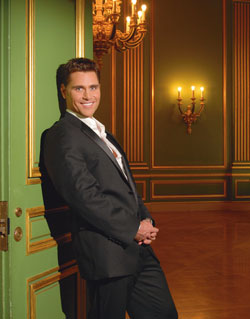
Jack Mackenroth
(Photo by Todd Franson)
Beyond that, it’s speaking to HIV-positive people about getting on the treatment that works for them, with minimized side-effects so they stay on their meds. It’s kind of how I live successfully and manage my illness, partnering early on with a doctor, getting on the treatment that was right for me early on — when there weren’t very many treatments. Figuring out what worked best for me, monitoring my health status, having a very open discourse with my physician — that’s really what we advocate. I’ve done well, so hopefully I’m kind of a role model of what is possible. I’m not Everyman’s HIV: “This is what can happen if you follow these rules!” But I am one example of someone living with HIV and managing my health care well.
The ultimate goal for people living with HIV is to have your viral load be undetectable, so we really stress that. I think that for people living in the HIV community, that seems like common sense. But for a lot of people, it’s not. I’m always surprised by the e-mails and the Facebook messages that I get where people ask these questions that should be common knowledge, but aren’t. So there’s a real need for programs like Living Positive by Design to keep the dialogue going.
All the stuff that I do works toward me being visible, because I want people to listen to what I have to say. If you think of whatever level of “celebrity” I have, if you think of people who are known nationally for being open about their HIV status — Magic Johnson, Greg Louganis, Ongina, that’s it — it’s an important message: There are people doing things you aspire to do living with HIV.
MW: Do you wish you’d had the sort of role model you’ve become at the time you learned you were HIV-positive?
MACKENROTH: Oh, yeah. Which is why I’m so happy to do it now. I wish more people would. I mean, come on. There’s a ton of people that are well known that could make a huge difference, but don’t.
I do remember the moment I found out about Magic Johnson. I do remember the Greg Louganis moment. But a lot of the campaigns then, which were very needed, were about prevention and being safe and getting tested. I don’t think there was anyone who really spoke to people already living with HIV.

Greg and Jack
(Photo by Courtesy of Jack Mackenroth)
I remember in the early ’90s it wasn’t surprising to find out someone was sick, and then three weeks later they’d be dead. In ’96, my boyfriend [Greg Leo Beutler] of a year and a half got really sick instantly and died in a week and a half. It was really traumatizing. It’s weird and awful to say, but when you’re around people who are sick and dying, it normalizes it in this really gross way that should never happen. When you deal with your mortality on a daily basis, it kind of changes the way you think — but it doesn’t make it any more pleasant. It wasn’t uncommon to be like, “Oh, I went to 10 funerals this year.” The human brain has this amazing capacity to learn coping mechanisms. Unfortunately, when you normalize something as gruesome as young people dying, it has a permanent effect on you. But you have to find a way to cope, or your brain will explode.
MW: Coming through that to today, HIV-positive for 20 years, you seem very optimistic.
MACKENROTH: Surprisingly, I am. [Laughs.] The whole “jaded New Yorker” thing’s not really true — just veneer. I think it’s because I come from humble beginnings. My mom did a really great job, but the circumstances weren’t great. I’ve managed to do some really amazing, fun, crazy, extraordinary things, so I guess I am pretty optimistic.
MW: Is that your nature? Have you always been this sort of sunny, self-confident guy?
MACKENROTH: No, not at all. Totally newly acquired. I was always effeminate — not this huge butch vision in front of you. [Laughs.] I was really tortured in high school. I just never felt like a part of any group. I had horrible self-esteem until college, and then it started cultivating. I had a group of friends like Free to Be… You & Me. Exploring design and art really helped me. I think I came into my own around 30. It took me awhile. And moving to New York, it’s like you’re thrown to the wolves. Living in Chelsea, it’s like survival of the fittest. I did really care a lot about what other people thought. Then I just sort of got over it.
MW: Before I let you go, I want to ask about a letter I saw posted on your Living Positive by Design site. The writer had such a hard time dealing with learning he was positive, but took so much inspiration from you. Have you ever done anything as gratifying as this project must be?
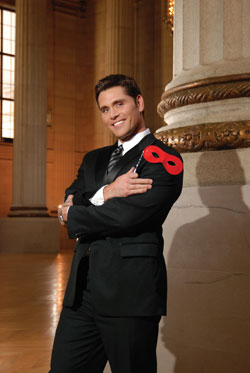
Jack Mackenroth
(Photo by Todd Franson)
MACKENROTH: Honestly, no. Never in my life have I had an experience like I’ve had with Living Positive by Design, where I know I change people’s lives. Making clothes is pretty and it’s fun. Going to fun events and meeting celebrities or whatever, it’s fun. It is what it is. But that e-mail is one of many that I’ve gotten, like people saying they were going to kill themselves when they found out they were HIV-positive, but then they read an article I was in or stumbled across my website, and changed their mind. How do you measure that success? It’s amazing.
Whitman-Walker Clinic’s 17th Annual Spring Gala, “Masquerade on the Mall,” is Friday, April 23, from 6:30 to 11 p.m. at Andrew W. Mellon Auditorium, 1301 Constitution Ave. NW. Tickets are $350 to $1,000, available by calling 202-797-3543 or visiting wwc.org/gala2010.
For more about Jack Mackenroth and Living Positive by Design, visit LivingPositiveByDesign.com and jackmackenroth.com.
Support Metro Weekly’s Journalism
These are challenging times for news organizations. And yet it’s crucial we stay active and provide vital resources and information to both our local readers and the world. So won’t you please take a moment and consider supporting Metro Weekly with a membership? For as little as $5 a month, you can help ensure Metro Weekly magazine and MetroWeekly.com remain free, viable resources as we provide the best, most diverse, culturally-resonant LGBTQ coverage in both the D.C. region and around the world. Memberships come with exclusive perks and discounts, your own personal digital delivery of each week’s magazine (and an archive), access to our Member's Lounge when it launches this fall, and exclusive members-only items like Metro Weekly Membership Mugs and Tote Bags! Check out all our membership levels here and please join us today!




















